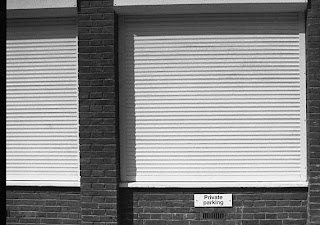I used to take a lot of black & white photos in my pre-digital days. In those days I had access to a darkroom and spent many hours there printing. Alas those days are long gone, but as I kept some developing tanks (and my film camera, a Nikon N70) at least I could process the negatives. You don't actually need a darkroom for that. And I have a scanner - which can scan 35mm negatives - so any subsequent processing can be done in Photoshop and then printed digitally.
Picked up where I left off all those years ago with Black & White film - Ilford Delta 400, rated at 400 iso. The shoot was to be an odd experience for me - keeping to the one iso rating and only 36 shots per roll.
Suggested interpretations of the theme, earlier, were of people in a private moment in a public space. My take was rather different - private/public signs. I'd seen plenty while exploring central London on previous shoots, and this time was no exception. Private/Public signs ? Signs - with writing or graphics - aimed at the public indicating something private. The brief required seven images, so here are those I selected.
I processed the negatives in Kodak HC-110 for 9 minutes, and found the results more grainy (noisy ?) than I would have liked. Perhaps if I was processing negatives more frequently I'd get back into the optimum chemistry for my type of work; then again the the negatives have also been scanned and not printed digitally and not in a darkroom. Out of practice ?









